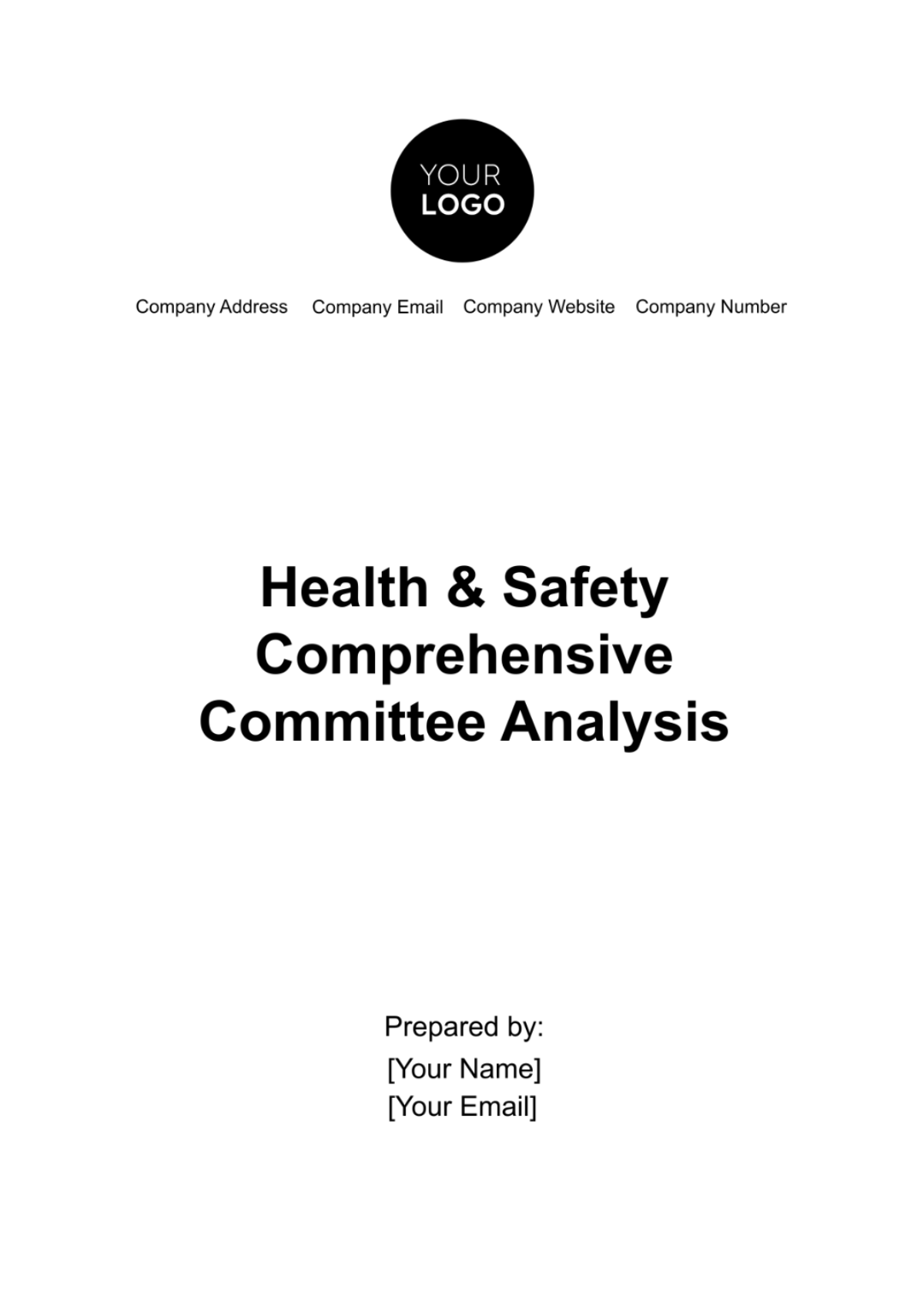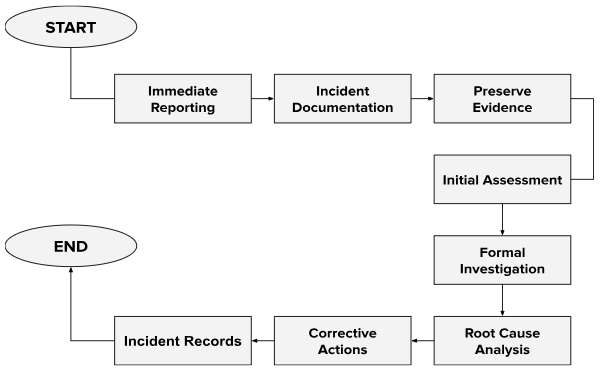Free Health & Safety Comprehensive Committee Analysis

Committee Analysis
A. Introduction
The Health & Safety Comprehensive Committee Analysis (HSCCA) serves as a crucial tool to assess and enhance the effectiveness of our organization's health and safety committee. Its primary purpose is to ensure compliance with US health and safety laws and standards, promoting a safe work environment for all employees. This analysis involves the active participation of various stakeholders, including the health and safety committee members, management, and employees, working collaboratively to achieve the shared goal of workplace safety and compliance.
B. Committee Structure and Composition
Our Health & Safety Committee Structure and Composition section outlines the organizational framework of our health and safety committee. Complying with relevant US laws and standards, we ensure that our committee is appropriately structured and staffed to address workplace safety effectively.
Committee Position | Name | Role and Responsibilities |
Chairperson | [Your Name] | Leads committee meetings, oversees safety initiatives. |
Our committee composition adheres to the requirements specified by US health and safety laws, ensuring diverse representation and effective safety management.
C. Meeting Frequency and Records
Our Health & Safety Committee conducts regular meetings to ensure the ongoing safety and compliance of our workplace. These meetings are scheduled [insert meeting frequency, e.g., monthly] and are essential for maintaining a proactive approach to safety.
It is of utmost importance that detailed meeting records are kept for every committee session. These records serve as an essential resource for tracking discussions, decisions, action items, and safety improvements over time. They also act as a documentation trail, which is crucial for demonstrating compliance with US health and safety standards.
In accordance with US standards, our meetings adhere to specific regulations, such as OSHA's requirements for safety committee meetings. These regulations outline guidelines for meeting frequency, record-keeping, and safety discussions, ensuring that our committee's activities align with the highest safety standards and legal requirements.
D. Communication and Training
Effective communication is paramount in ensuring that employees are aware of and engaged in health and safety matters. Our committee employs the following methods to communicate vital information:
Regular Safety Meetings: We conduct monthly safety meetings to discuss safety updates, concerns, and important information with employees.
Notice Boards and Email Alerts: Important safety notices, updates, and reminders are posted on notice boards and sent via email to reach all employees promptly.
Training Sessions: Employees receive training on safety protocols during onboarding and through periodic refresher courses.
Training Programs for Committee Members
Committee members play a pivotal role in promoting safety. We ensure they are well-prepared through:
Orientation Training: New members undergo comprehensive orientation to understand their roles and responsibilities.
Continuing Education: Committee members receive ongoing training to stay updated on changing safety regulations and best practices.
External Workshops: Members may attend external safety workshops and seminars to enhance their knowledge.
E. Hazard Identification and Risk Assessment
Identifying workplace hazards is the foundation of our safety program. We follow a systematic approach that includes:
Regular Inspections: Trained safety personnel conduct routine inspections of all work areas to identify potential hazards.
Employee Reporting: We encourage employees to report hazards promptly, fostering a proactive safety culture.
Incident Analysis: We analyze past incidents to uncover underlying hazards and prevent recurrence.
Conducting and Documenting Risk Assessments
Risk assessments are vital in evaluating the severity and likelihood of identified hazards. Our process includes:
Risk Matrix: We use a risk matrix to assess hazards, considering their impact and likelihood.
Documentation: Each hazard is documented, including its description, location, risk level, and mitigation plan.
Regular Review: Assessments are regularly reviewed and updated to reflect changing conditions.
Compliance with US Safety Standards
Our hazard identification and risk assessment processes strictly adhere to US safety standards, including those outlined by OSHA. This ensures that our approach to hazard management aligns with the highest safety requirements, providing a safe working environment for all employees.
F. Incident Reporting and Investigation
Timely and accurate incident reporting and investigation are essential aspects of our commitment to workplace safety. This section outlines our comprehensive process for reporting and investigating workplace incidents, ensuring that every incident, no matter how minor, is thoroughly examined to prevent recurrence and comply with US safety regulations.

Our commitment to incident reporting and investigation is in full alignment with US safety regulations, ensuring transparency, accountability, and continuous improvement in workplace safety.
G. Recommendations and Action Plans
Our health and safety committee actively engages in the process of generating safety recommendations through a collaborative and data-driven approach. This involves:
Data Analysis
Committee Discussions
Expert Input
Development and Implementation of Action Plans
Once safety recommendations are established, the following steps are taken to develop and implement action plans:
Prioritization ↓ Action Plan Formulation ↓ Implementation |
Our processes align with US standards for safety recommendations and action plans, ensuring that our safety improvements meet regulatory requirements and industry best practices.
H. Regulatory Compliance
Our health and safety committee operates in strict compliance with several key US health and safety regulations, including:
Occupational Safety and Health Act (OSHA): This federal law sets forth safety and health standards in the workplace, and we adhere to OSHA's regulations to ensure employee safety.
Environmental Protection Agency (EPA) Regulations: We also comply with EPA regulations regarding hazardous materials and environmental safety.
National Institute for Occupational Safety and Health (NIOSH) Guidelines: We follow NIOSH guidelines to promote safe working conditions.
Ensuring Compliance
Our committee ensures compliance with these regulations through:
Regular Audits: We conduct routine audits to identify and address any compliance gaps.
Training Programs: Employees receive training on relevant regulations to ensure awareness and understanding.
Documentation: Detailed records of compliance efforts, audits, and training are meticulously maintained.
Recent Regulatory Updates
Any recent regulatory updates are promptly reviewed by our committee. We assess their impact on our operations and update our policies and procedures accordingly, ensuring ongoing compliance and the highest level of safety standards.
I. Monitoring and Evaluation
Our health and safety committee employs a robust approach to monitor the effectiveness of safety measures:
Incident Tracking: We maintain a comprehensive incident database, tracking the frequency, type, and severity of workplace incidents to identify trends and areas for improvement.
Safety Inspections: Regular safety inspections and audits are conducted to assess the implementation of safety measures and identify potential hazards.
Safety Surveys: Employee surveys and feedback mechanisms allow us to gauge employee perceptions of safety and identify concerns.
Evaluating Committee Performance
We continuously evaluate the performance of our health and safety committee:
Annual Reviews: The committee undergoes an annual performance review, assessing its achievements, challenges, and areas for growth.
Adherence to KPIs: Key performance indicators (KPIs), such as incident rate reduction and compliance with safety regulations, are closely monitored.
Feedback Channels: We solicit feedback from employees and management to assess the committee's effectiveness in promoting a safety culture.
Our approach ensures that safety measures remain effective, and the committee's performance aligns with the overarching goal of enhancing workplace safety
J. Continuous Improvement
Our health and safety committee maintains a proactive stance by continually identifying areas for improvement through:
Data Analysis: Regular analysis of incident reports, audits, and safety surveys helps pinpoint areas with recurring issues or emerging trends.
Benchmarking: We compare our safety performance against industry benchmarks and best practices to identify gaps.
Making Continuous Enhancements
Continuous enhancements are a core focus of our committee:
Action Planning: Once improvement areas are identified, action plans are developed and implemented.
Feedback Loops: Employee and management feedback loops ensure that adjustments are made as needed.
Adapting to Evolving US Health and Safety Standards
Our commitment to adapting to evolving US health and safety standards is unwavering. We closely monitor changes in regulations, promptly update our policies, and provide necessary training to ensure full compliance and the highest level of workplace safety.
- 100% Customizable, free editor
- Access 1 Million+ Templates, photo’s & graphics
- Download or share as a template
- Click and replace photos, graphics, text, backgrounds
- Resize, crop, AI write & more
- Access advanced editor
Explore Template.net's Health & Safety Comprehensive Committee Analysis Template, a robust tool for evaluating committee effectiveness. Effortlessly customize and edit analyses with our AI Editor Tool to fit your organization's needs. Enhance safety initiatives with this editable and customizable solution, ensuring optimal committee performance and workplace well-being.





























